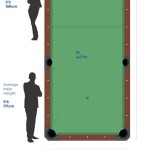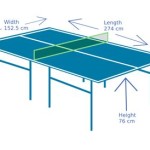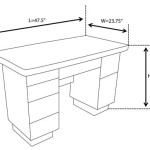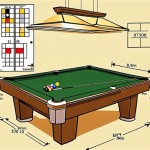What Are The Dimensions Of A Regulation Ping Pong Table
The game of ping pong, also known as table tennis, is a globally recognized sport enjoyed by casual players and professional athletes alike. At the heart of this sport lies a standardized piece of equipment: the ping pong table. Understanding the precise dimensions of a regulation ping pong table is crucial not only for competitive play but also for recreational enjoyment, ensuring fair and balanced gameplay. These dimensions are strictly defined by the International Table Tennis Federation (ITTF), the governing body for the sport. Adhering to these standards allows for consistent play and skill development, irrespective of the playing location.
The ITTF meticulously outlines the specific requirements for a table to be considered regulation-compliant. This encompasses not just the length and width, but also the height, materials used, and even characteristics like the surface's reflectivity. Each of these attributes plays a role in the overall playing experience and ensures a level playing field for all participants. Variations from these standards can significantly alter the pace and trajectory of the ball, impacting the strategy and skill required to play effectively.
Regulation Table Dimensions: Length and Width
The primary dimensions defining a regulation ping pong table are its length and width. According to the ITTF, a regulation ping pong table must measure 2.74 meters (9 feet) in length and 1.525 meters (5 feet) in width. This rectangular shape provides the playing surface for both single and double matches. These precise measurements are critical for maintaining consistency across all levels of play, from casual backyard games to high-stakes international tournaments. Players develop their strategies and techniques based on these known dimensions, learning to anticipate ball movements and court coverage effectively.
The defined dimensions are not arbitrary; they have evolved over time to optimize the gameplay experience. The 9-foot length allows for a sufficient range of motion and shot placement, while the 5-foot width offers a balance between challenging opponents and maintaining manageable court coverage. Deviations from these dimensions, even by small margins, can noticeably affect the game. For instance, a slightly shorter table might make it harder to execute deep shots, while a wider table could favor players with exceptional reach and footwork.
Manufacturers are expected to adhere closely to these specifications when producing tables intended for competitive use. Quality control measures are often employed to ensure that each table meets the ITTF standards. This includes precise cutting and assembly techniques, as well as careful monitoring of material properties to avoid any unintentional deviations from the required dimensions. Even seemingly minor variations can accumulate and significantly impact the playing characteristics of the table.
Regulation Table Dimensions: Height
In addition to the length and width, the height of a regulation ping pong table is also precisely defined. The playing surface must be 76 centimeters (30 inches) above the floor. This height is consistently maintained across all legal playing surfaces, which is a crucial factor in determining the ball's trajectory, bounce, and overall playability. The specified height allows players of varying statures to comfortably reach and play shots, promoting fair and balanced competition.
The height requirement is designed to allow players to generate topspin and backspin effectively. The lower height allows for better control by the player to impart spin on the ball. Tables that are outside this measurement makes the game more difficult and less fun. The height is checked using specialized equipment to ensure that consistency is being maintained.
Maintaining the correct table height is essential for ensuring fairness and accuracy in gameplay. As with length and width, manufacturers must carefully control the production process to meet this specification. Variations in height can significantly alter the ball's bounce and trajectory, impacting the strategies and techniques used by players. A table that is too low may make it difficult to generate adequate power, while a table that is too high could make it harder to control the ball's placement.
Additional Table Specifications: Surface and Markings
Beyond the basic dimensions, other characteristics of a regulation ping pong table are also defined. The playing surface must be uniform and provide a consistent bounce. Typically, the surface is made of wood or a wood-based material, coated with a special paint or finish to achieve the desired playing characteristics. The color is usually dark, typically dark green or blue, with a matte finish to reduce glare and improve visibility of the ball. The surface must also be free of any defects or imperfections that could affect the ball's trajectory.
The surface reflectivity is another important consideration. A highly reflective surface can make it difficult to track the ball, particularly under bright lighting conditions. Therefore, regulation tables are designed with a matte finish that minimizes glare and provides optimal visibility. The surface also needs to be durable and resistant to wear and tear, as ping pong tables are often subjected to heavy use. The surface coating is typically designed to withstand repeated impacts from the ball and resist scratches or other damage.
Further, a regulation ping pong table must feature specific markings. A white line, 2 centimeters (0.8 inches) wide, runs along the perimeter of the table to define the playing area. This line is known as the edge line. Additionally, a white center line, 3 millimeters (0.12 inches) wide, runs down the middle of the table, dividing it into two halves. This center line is only relevant for doubles play, where it designates the service areas. These markings are crucial for determining whether a ball is in or out of bounds and for ensuring correct service during doubles matches.
The net assembly, which is also part of the regulation specifications, is similarly important. The net must be 15.25 centimeters (6 inches) high and extend across the width of the table, dividing it into two equal halves. The net must be suspended by a cord attached to two posts, positioned outside the side lines of the table. The posts must be stable and adjustable to ensure that the net is properly tensioned and maintains the correct height. The color of the net is also specified, typically a dark color, to provide a clear contrast against the white ball.
In summary, a regulation ping pong table is a carefully engineered piece of equipment, designed to provide a consistent and fair playing surface. The dimensions and characteristics outlined by the ITTF are essential for ensuring that the game is played according to established rules and standards. From the length and width to the height, surface properties, and markings, each element plays a critical role in the overall playing experience. Adhering to these specifications is crucial not only for competitive play but also for recreational enjoyment, ensuring that players of all levels can experience the game at its best.

Table Tennis Dlgsc

To Choose The Right Table Tennis Size For You Stiga Sports

Ping Pong Table Dimensions Ponghero

Table Tennis Measurements Size And Dimensions Cornilleau

To Choose The Right Table Tennis Size For You Stiga Sports

Table Tennis Room Size Court And Dimensions

Ping Pong Table Dimensions The Guy

Table Tennis Tables Which Is Right For Me Hart Sport New Zealand

Table Tennis Buyer S Guide Liberty
To Choose The Right Table Tennis Size For You Stiga Sports
Related Posts








